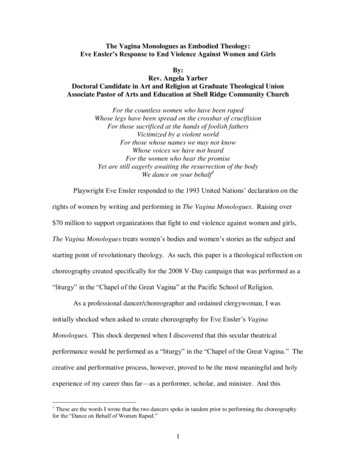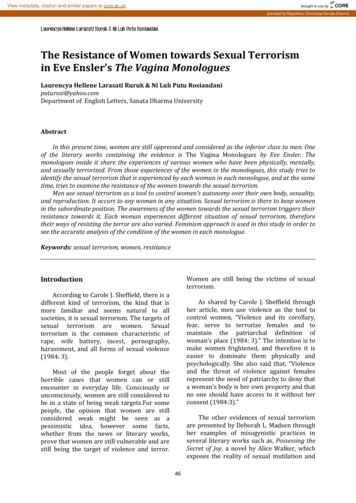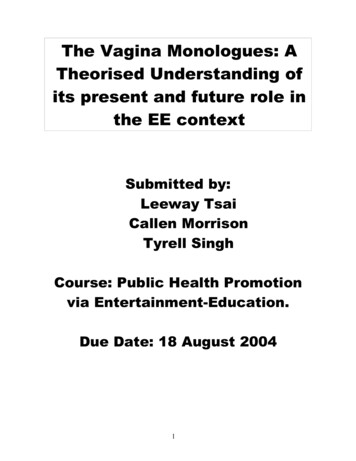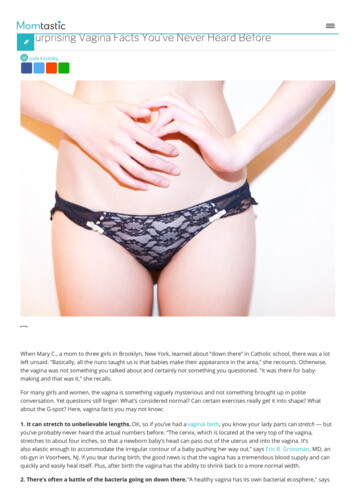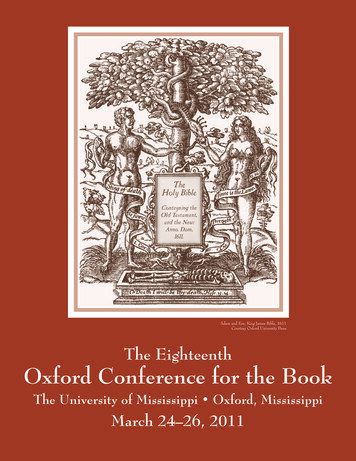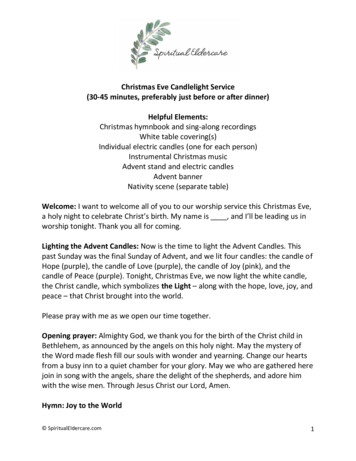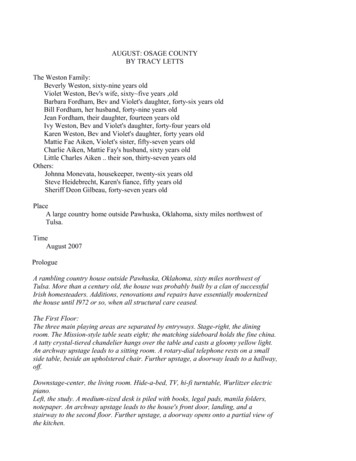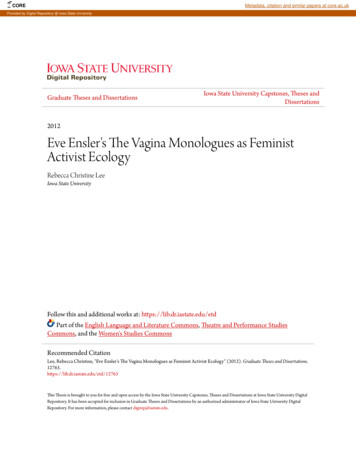
Transcription
COREMetadata, citation and similar papers at core.ac.ukProvided by Digital Repository @ Iowa State UniversityGraduate Theses and DissertationsIowa State University Capstones, Theses andDissertations2012Eve Ensler's The Vagina Monologues as FeministActivist EcologyRebecca Christine LeeIowa State UniversityFollow this and additional works at: https://lib.dr.iastate.edu/etdPart of the English Language and Literature Commons, Theatre and Performance StudiesCommons, and the Women's Studies CommonsRecommended CitationLee, Rebecca Christine, "Eve Ensler's The Vagina Monologues as Feminist Activist Ecology" (2012). Graduate Theses and /12763This Thesis is brought to you for free and open access by the Iowa State University Capstones, Theses and Dissertations at Iowa State University DigitalRepository. It has been accepted for inclusion in Graduate Theses and Dissertations by an authorized administrator of Iowa State University DigitalRepository. For more information, please contact digirep@iastate.edu.
Eve Ensler’s The Vagina Monologues as feminist activist ecologybyRebecca Christine LeeA thesis submitted to the graduate facultyin partial fulfillment of the requirements for the degree ofMASTER OF ARTSMajor: English (Literature)Program of Study Committee:Kathy Hickok, Major ProfessorLinda ShenkGloria Jones-JohnsonIowa State UniversityAmes, Iowa2012Copyright Rebecca Lee, 2012. All rights reserved.
iiTABLE OF CONTENTSINTRODUCTION: THE VAGINA MONOLOGUES AS FEMINIST ACTIVISTECOLOGY1CHAPTER 1: THE SOCIALITY OF READING THE VAGINA MONOLOGUES15CHAPTER 2: NEGOTIATING INTERSECTIONALITY, TRANSNATIONALITY,AND REPRESENTATION44CHAPTER 3: PEDAGOGY, PERFORMANCE, AND POLITICAL CHANGE71CONCLUSION96WORKS CITED98
1INTRODUCTION: THE VAGINA MONOLOGUES AS FEMINIST ACTIVIST ECOLOGYSince Eve Ensler debuted The Vagina Monologues (TVM) in New York City’s HEREtheater in 1996, thousands of women have experienced the play and subsequently found acommunity of feminist activists using literature to reclaim their bodies, share their stories,and integrate discussion of the vagina into public discourse. From across the globe, localgrassroots activists participate together in a transnational ecology—a term I use tocharacterize the context of the performance, including fellow activists, feminists, the nonactivist identified public, time, place, performance space, and sociocultural influences andattitudes across geopolitical borders. The central organization, known as V-Day, has madeformative strides in changing the conversation on women, women’s bodies, and violenceagainst women and girls.For nearly fifteen years, the movement has taken up the charge of making vaginas“integrated and respected and sacred” in everyday language, but even as recently as June 13,2012, Michigan state legislator Rep. Lisa Brown was reported as saying a word “sooffensive” some fellow representatives argued it should not have been spoken in “mixedcompany” (The Vagina Monologues xxiv; Peralta). In a statement about proposed abortionregulations, Brown remarked, “I’m flattered you’re all so interested in my vagina, but nomeans no;” as a result, she was barred from speaking on the House floor (Peralta). Ironically,Majority Floor Leader Jim Stamas’ attempt to keep the “vagina” out of politics and publicforums has only brought the word greater public attention; the media took notice, feministactivists rallied in outrage, and Brown took to the Michigan Capitol steps not only to defendher use of the word vagina, but to insistently repeat it—upwards of 128 times—in a highlypoliticized, public reading of Ensler’s The Vagina Monologues.
2While the controversy has yet to be resolved, Brown’s performance has alreadybrought reenergized attention to the play and its exigency: breaking the cultural silenceimposed on vaginas and women’s embodied experiences. Ensler conceived the play as a“place to release the myths, shame, and fear” of the vagina, and TVM has since become aninternational sensation, indeed a space for connecting, healing, and organizing as acommunity (The Vagina Monologues xxv). As the most prominent performance in theextensive V-Day movement, TVM is the creative vehicle by which communities worldwidebring forth the call to end violence against women and girls. However, according to themovement, “Performance is just the beginning” (10th Anniversary Ed. 171). Thus, my focusin analyzing TVM as a vibrant ecology of feminist activists is to examine the interdependentrelationships within V-Day—among the texts, contexts, activists, listeners, scholars, publics,and environments—each of which contribute to consciousness of and actions to end violenceagainst women.V-Day: A Brief OverviewEve Ensler first performed The Vagina Monologues alone on an off-Broadway stagein New York City in 1996. Over the next two years, what began as a critically-acclaimed,one-woman show transformed into an antiviolence movement: V-Day. The script arose frominterviews that Ensler conducted with more than 200 women about their vaginas, andfollowing each performance, Ensler was approached by numerous women “who shared theirown stories of surviving violence at the hands of relatives, lovers, and strangers” (10thAnniversary Ed 169). From these encounters, the vision for a large-scale movement to endviolence against women was born. In appropriate fashion, Ensler officially founded V-Day asa 501(c)(3) on February 14, 1998; the V in V-Day stands for “victory”, “valentine”, and
3“vagina,” and the organization immediately began bringing together activists who wouldstage benefit productions of TVM to increase awareness and raise money to stop violence(171). A crew of New York-based volunteers produced the first benefit performance of TVM,which featured a celebrity cast of well-known women entertainers and raised approximately 250,000 for V-Day.Today, any analysis that separates TVM from V-Day is a problem, given that theorganization has grown into a massive, worldwide initiative, and has raised more than 85million for anti-violence programs (Bell and Reverby; “Donate to V-Day”). This is preciselythe issue I seek to reframe in examining the play as an ecology rather than an isolated text orperformance piece. First and foremost, there are the people involved. A small team of twelvepaid staff, called the “V-Core,” manage the non-profit’s infrastructure, and a “V-Board” of20 women from entertainment, business, and private sectors, including Ensler, “providevision, leadership, and wisdom” for the organization; however, the majority of the movementare the thousands of activists who have brought V-Day events1 to six continents, in more than500 cities, across more than 140 countries, in 45 languages (2011 Annual Report 26). Now,in approach of its fifteenth anniversary, V-Day has undertaken its most ambitious campaignyet: to recruit “One Billion Women” to take a stand against sexual and domestic violence onFebruary 14, 2013.In recruiting activists and promoting education, V-Day uses creative programming,most notably performances of TVM, to catalyze grassroots anti-violence activism across the1While I am focusing on The Vagina Monologues as V-Day’s primary work of art and activist event, it isimportant to recognize that within the last five years, V-Day events can include additional activist performanceproductions (A Memory, A Monologue, A Rant and a Prayer and Any One of Us: Words from Prison), filmscreenings (What I Want My Words to Do To You and Until the Violence Stops), and workshop presentations(Congo Spotlight Teach-In, Haiti Spotlight Teach-In, V-Men workshop and presentation, V-Girls academiccurriculum and book club, and “Over It” writing and speaking workshop).
4globe. Though the organization’s successes largely depend on TVM’s “formal status as awork of literature and staged performance text,” the play digresses significantly fromtraditional theatre because of its activist priorities (Hammers 240). In this vein, as a growing,changing movement, V-Day relies on art that also changes; there are numerous editions ofthe play, more so than one would expect of a formal text that was written less than 20 yearsago, in 1994. The most widely available, published circulations are three book editions—TheVagina Monologues (1998), V-Day Edition (2001), and 10th Anniversary Edition (2008),each of which can be purchased online or in stores from major booksellers. However, theversions that activists perform worldwide—the Official V-Day Scripts—are available onlythrough V-Day itself, requiring campuses and communities to register their events, abide bycertain guidelines, and report their fundraising proceeds—thus resulting in a closer regulationof the art that is performed in affiliation with V-Day2.Registered V-Day organizers, in return, receive yearly updated scripts to distributeamong their casts, as well as access to an archival library through V-Day’s online activistportal, V-Spot3. Given the 90-minute duration of the performance and the addition of newmonologues, Official V-Day Scripts may vary significantly from one year to the next orremain quite similar. Some monologues, such as “Reclaiming Cunt” and “The Woman WhoLiked to Make Vaginas Happy,” have gained cult status and are included in every singleproduction. Other monologues, such as “Smell” and “I Was Twelve. My Mother SlappedMe,” have been included some years, but not others. Further still, in later years, official2There is, however, an Acting Edition of the play that is available for purposes of performance unaffiliated withV-Day. This particular edition is available at cost through Dramatists’ Play Service.3Having never organized a V-Day event, I have limited access to V-Spot; for this reason, among otherconsiderations, V-Spot discourse is beyond the scope of my analysis at this time. I mention it here only forpurposes of outlining how the play circulates within public spheres.
5scripts have offered community and campus activists a selection of optional monologues 4that they may choose to include or not include at their own discretion. Given the changes andchoices V-Day provides to activists each year, as well as the nature of grassroots activism asa shifting, evolving practice, productions may vary significantly from one to the other overtime and geopolitical location. Activists and the monologues they read hence construct anetwork of artistic performances that are diverse and dynamic, but interdependent in theirconnection to V-Day and dedication to ending violence against women and girls.Though V-Day activists across the many productions of TVM diverge at criticalintersections, and may or may not explicitly identify as feminists, the play invokes feministvalues of community, collaboration, and shared power. The introductory vignette begins bycalling attention to and questioning the paradigm of silence and shame surrounding vaginas,framed as a feeling of “worry”; on stage, a woman reads: “We were worried about our ownvaginas. They needed a community, a context, a culture of other vaginas” (Official Scripts2012 1). Immediately, readers present the play’s purpose in ecological terms, as establishinga “community,” and in the social terms of a “culture,” suggesting the female body as needingconnection to other female bodies—calling for a public space in which women can discusstheir vaginas and the realities of their embodied lives. V-Day activists then construct a publicperformance that focuses on women’s formerly private experiences, including looking attheir vaginas, masturbating, shaving, menstruating, engaging in sexual acts, giving birth,being medically examined, being abused, and being raped. In sharing embodied experiences,TVM presents women in interdependent relations with one another, based on the4Optional monologues are typically “Spotlight Monologues” from previous years. For more on this aspect ofTVM, see my analysis in Chapter 2: Negotiating Intersectionality, Transnationality, and Representation.
6commonalities among their stories—particularly of sexual violence. Sharing common vaginalexperience thus fosters a community of more feminist-conscious women, and educates men,as well, so that together they can take collective action.Furthermore, the performance has created and continues to create a series of publicspaces for recognition of violence against women in the global public sphere, where legal,social, and cultural protections are lacking. By publicly reading aloud detailed narratives ofwomen’s subjective, bodily experiences, V-Day activists propose to change the conversationon women’s lives in a way that raises awareness of and subsequently ends the ongoing globalviolence against women and girls. Thus, there is a striking call for examination on how theseevents come together, with what knowledge they leave participants, and how that knowledgeis agreed upon, but also how the play meets resistance to its representations within public,feminist, and academic spheres.Problems and Potential: A Review of TVM CriticismMichele Hammers notes that TVM is “a richly problematic text for feminist activists andscholars alike,” with a particular emphasis on the rhetorical configurations of the femalebody (223). Most poignantly, scholars express tensions over the vagina as a metonym for thewhole of female consciousness, sexuality, and the core of women’s identities (Cooper 732).Ensler has been quoted in interviews as saying, point-blank, “The story of a woman’s vaginais the story of her life” (Hammers 234). In one light, as a critique of domination, TVM offersa way to “reclaim the vagina” as part of subjective experience (234). However, the play’sthreat of “reduc[ing] women to nothing more than their vaginas and vagina-relatedexperiences” and of co-optation by “biology-as-destiny” theorists are two major tensionsamong scholars and feminists (234). For, even if one can celebrate the reunion of the self
7with the body, Susan Bell and Susan Reverby raise the problem of using “vagina” asshorthand for vagina, cervix, clitoris, labia, and sexual experiences together—whichreinforces a male-centered view of the vagina as a woman’s primary sexual organ (431).Rather than celebrate the play’s reclaiming of the vagina, scholars have drawn on first-wavefeminist influences Simone de Beauvoir and Mary Wollstonecraft, as well as queer theoristJudith Butler, to push for a liberated sexed identity that is discrete from the body (Cooper,Hall). Both Cooper and Kim Hall argue that TVM does little to challenge dominantconstructions of “woman” as fixed on the vagina. Hall poignantly argues:The vagina, like the category ‘woman’, is a political category. That is, the vaginais made intelligible to the extent that it perpetuates the notion that the (biological)capacity to give birth is what makes one a woman (Wittig 1992, 10). Thus, withina heteropatriarchal society, having a vagina is what makes one a biologicalwoman. So, to engage in the project of reclaiming the vagina withoutsimultaneously adopting a strategy of disidentification regarding the reality of thevagina does not challenge the social, political, historical, and economic contextthat imbues the vagina with meaning. (113)By Hall’s argument then, participants leave TVM with a surge of power and pride, areclaiming of the vagina as part of subjective experience, but as such have furtherinternalized the normative identity of “woman” without conscious contemplation of sex orgender—which, for Hall, is a problem in that it effectively erases queer identity andexperience, and for Cooper is a failure of a project that purports to teach feminism.Similarly, there is little contemplation of nationality, ethnicity, and race as socialcategories; while neither nationality nor race is erased from the conversation, and although
8V-Day promotes diversity throughout its rhetoric, scholars argue that TVM does little tocritique its own white First World origins. Cooper uses the intertwined tropes ofconsumerism and colonialism to describe TVM in terms of “consumable feminism” (Cooper727), “missionary feminism” (745), and “marketplace activism” (753), wherein “globalfeminism” is invoked as primitive, yet fashionable, and consumable while remaining at aninherent distance (Basu). Under this lens, Srimati Basu poignantly asks: “Who is called uponas the recipient and consumer, either of the play or of its attendant products?” (36). Inresponse, one might look at one of the most immediate patterns among the monologues:“Rape is represented directly in the script only in monologues where the speakers are womenof color.voices of American whiteness have their vaginas and selves intact” (Cooper 749).In these representations, TVM utilizes stereotyped Africanist and Orientalist images whileplaying to a track of “American voice-overs and interpretations of other women’s lives”(Bell and Reverby 431). Such a nationalist framework ultimately erases the context ofspecific conflicts and collapses oppressions associated with patriarchy, religion, culture, andpolitics—overall colonizing the very women it purports to empower (Basu 44). Althoughthese scholars insist that there remain many exciting possibilities for cross-culturalcommunication and solidarity in TVM, they see Ensler’s current representation of ThirdWorld women as antithetical to the overall spirit of global feminism.For many scholars, however, it is the form of the monologue, as opposed to adialogue, that promotes Ensler’s perceivably singular vision of the world, as opposed to“calling forth diverse national and ethnic understandings of sex or intimacy” (Bell andReverby 431; Basu 39). Cooper argues that as an outgrowth of second wave feminism andthe traditions of consciousness-raising, the stylized monologues “convert conversations—
9questions and answers between two women—into the personal, at times confessional, speechof a solitary female subject,” subsequently reducing speakers to “versions of the same” whoare speaking for all women (729). Yet it is this very form of the “confessional” that CathleenKaveny argues allows victims to reclaim agency. Kaveny argues, “As with victim-impactstatements, the first-person, confessional form of the monologues is inseparable from theirmessage. In a sense, the person is the message” (15). At the same time, they assist thecommunity in formulating and appropriately enforcing its legal and moral norms (14). In thislight, the stylized approach of the performance content poses immense possibilities fordialogue and connection, but evokes feminist tensions among those who are skeptical ofTVM’s potential for colonizing survivors of violence.In this vein, Cooper raises the point that although TVM participants have raised morethan 85 million for antiviolence programs, it is problematically “unclear how, or whether,they connect to the grassroots activists sponsored by their endeavors or even their localcommunities” (754). While the extent to which V-Day performers engage in other forms ofactivism is beyond the scope of my analysis at this time, it is in this vein that I focus myscholarly attention on how V-Day activists connect to one another within the ecology ofTVM. I reject the notion that TVM as performance activism5 is inherently less valuable or lessproductive in ending violence than the many other organizations that have received fundsfrom V-Day locales6. Therefore, I offer a transactional view of TVM as an activist ecology as5Rachel Kutz-Flamenbaum’s broad definition of “performance” applies to a “continuum ranging from highlystructured and formal to loosely structured and informal” events that include one or more performativeelements, such as costumes, skits, actions, song, dance, and character (90). This is a concept I explore morefully in connection with TVM in Chapter 3.6The list of organizations that benefit from TVM Campaigns is published yearly in V-Day’s annual report.However, to my knowledge, no collective analysis of V-Day beneficiaries has been conducted. With that in
10a point of entry in understanding how the very act of reading the monologues, as a socialpractice, fosters a community and thus furthers, in part, the mission of V-Day.The Vagina Monologues as EcologyThe metaphor of “ecology” has an established place in women’s studies, under the branchof ecofeminism—broadly understood as the interdisciplinary confluence of concerns forwomen and concerns for the environment, given the sensibility that the two run parallel orperhaps are one and the same with regard to a lack of respect and care for women andecosystems. Ecofeminists believe that there are important connections between thedomination and subjugation of women and the domination and subjugation of the earth.Notable ecofeminist Ynestra King writes, “The ecological crisis is related to the systems ofhatred of all that is natural and female by the white, male, Western formulators ofphilosophy, technology, and death inventions” (qtd. in Warren 76). Given the interdependentnature of women and the earth, the “ecological crisis” King refers to here has implications ofequal weight for the “women’s crisis,” and it is from this conceptual framework that I derivemy argument of V-Day as an ecology—a term that particularly emphasizes theinterdependency of all life forms and the environment, not as two parts of the same system,but together as the system itself. In other words, V-Day activists cannot be analyzed as apartfrom the context of the performance, including fellow activists, feminists, the non-activistidentified public, time, place, performance space, and sociocultural influences and attitudes7.mind, it is particularly presumptuous to assume that V-Day performers’ involvement in these organizationswould be any more in line with the values or projects of feminism that Cooper finds missing in TVM.7Much of ecofeminism works to deconstruct the dichotomy between humans/non-humans as part of integratingunderstandings of women and nature. Admittedly, this component is left unexplored within my current project,given V-Day’s exclusive focus on human women and girls.
11What the metaphor of “ecology” also does foremost is assert the interconnectednessof activists. By reading TVM as an activist ecology, as opposed to an atomistic text, I open uppositive ethical implications largely rooted in Karen J. Warren’s model of “care-sensitive”ethics, which promotes care as a core, essential value with three ethical pillars: (1) the abilityto care for oneself and for others is essential to moral reason; (2) we must understand aprinciple of “situated universalism,” or in other words, that what is universal to humans isrelative to a specific sociopolitical context; and (3) the suitability of an ethical principle isdetermined in part by care (108). In this vein, ecofeminist ethics ask one to assess moralconduct in terms of “care, friendship, and appropriate trust,” rather than in the hierarchicalschema of justice—which assesses moral conduct based on rights, duties, and rules (112).Justice asks one to discern right from wrong, good from bad; care asks one specifically tolisten, to respect, and to build relationships. Though V-Day activists assert women’s rightsnot to be violated or raped, the play’s rhetoric and processes of negotiation largely engagepersuasion by fostering the relationships, trust, and shared empowerment associated morewith Warren’s ecofeminist model of care, rather than hegemonic ideologies of justice. Thus,by engaging public discourse under an ethic of care, TVM exists as an exciting site ofecofeminist analysis and ought to be evaluated in terms of ecology.I do not mean to be dismissive of Ensler’s writing craft or of the very text of TVM ascentral to the movement; however, I do want to suggest that as part of an ongoing reflectionand reevaluation, one ought to account for the agency of multiple activists who enact andattend V-Day events and participate in its ongoing discourse. The surge of V-Day activism, Iargue, is arising not because of Ensler’s power as an author/performer-in-authority (thoughshe is well-established as the key figure), but rather because of the literary transactions
12among V-Day activist-performers, audiences, the local environment, and larger culturalforces. While there is much work to be done with the text, and room for countless analysesof Eve Ensler as a key activist figure, as a scholar, I am focusing less on the ways aplaywright’s “control” effects persuasion and more on local participants who bring their ownexperiences to the acts of reading, listening, and interpreting—thereby negotiating meaningthrough an interdependent network of rhetorical exchanges.Like much scholarship on TVM, my analysis originates from my own encounter withthe text in affiliation with V-Day. The first edition I ever read was The Official Script for the2009 V-Day Campaigns when, as a college junior at Drake University, I joined the campuswomen’s activist group and auditioned to be part of the cast. Since then, I have joined thisgroup of women at my alma mater in Des Moines, Iowa, every February to read TVM. Thusmy perspective of the production and V-Day as a whole is inevitably nuanced by an informal,yet longitudinal, autoethnography of sorts. Most significantly, I have the unapologeticperspective of an activist, and my engagement with the Official Scripts is logistically limitedto later years, 2006-20128. However, while my scholarship is intricately linked to myactivism, my activism is not limited to TVM or to V-Day. Further, I argue there is invaluablesignificance in ongoing self-reflection, as well as commitment to critiquing the intersectionsof oppression and privilege. Particularly, by putting the movement beneath the intersectinglenses of feminist rhetorical and pedagogical theories, activists can create a space for a moreethical feminism that reasserts the importance of (1) dialogical listening across social andgeopolitical boundaries and (2) equitable representation of women both as individuals and in8A generous thank you to Rachel Gulick, who shared with me her “Vagina Binder,” with official scripts andrelated artifacts from 2006-2007.
13relation to one another, to their immediate context, to the global sphere. In hoping toarticulate practices of negotiation and working together, I offer feminist modes of rhetoricand ethics as a point of entry for unpacking the underpinnings of TVM as V-Day discourse.My scholarly contribution, thus, emerges in a reciprocal relationship with my activism, inthat I cannot switch between modes of academic theorizing and activist declaiming, for in mylife they are one in the same.With that said, in arguing for accountability and self-reflection of one’s role in V-Day’secology, I acknowledge that my vision has been both enabled by and constrained by theembodied standpoints from which I see the world. The reading I offer here has certainly beenshaped by my privileged position as a white, American, middle-class female; by my currentposition as a graduate student in a public university with a primarily young, white, and classprivileged student body; by my experiences as a V-Day College Campaign activist in theAmerican Midwest; and by my commitments to social justice, feminism, and anti-racism.Thus, my reading and listening experience is confined to university spaces that arehistorically rooted in, if not currently participating in, the same First-World nationalist,predominantly white feminist perspectives that I critique in my later chapters. However, myecofeminist and intersectional influences lead me to engage in a reflective critique of the veryprivilege that enabled my encounters with TVM as a student activist—and ask me to engagein ongoing reflection on my participation in the production. Therefore, the reading I give hereis but one of many possible interpretations, and I have no desire to make some kind ofdefinitive statement about TVM or the V-Day movement—for certainly to do so would beentirely antithetical to my very proposition. However, I do hope to inspire readers, scholars,and fellow activists to continually reflect on the implications of V-Day work in ending
14violence against women and girls, which can help us reimagine what it means to be afeminist activist in a global ecology.
15CHAPTER 1: THE SOCIALITY OF READING THE VAGINA MONOLOGUESThe Vagina Monologues, as an evolving script, exists as playwright Eve Ensler’sinterpretation of the experiences of more than two hundred women, whom she interviewedover the course of years. Ensler and V-Day Campaign organizers insist that performers areactivists, not actors. That said, I argue that activists are furthermore rooted in aninterdependent ecology marked by their practices and processes of reading, listening, andnegotiating meaning of the script. Each woman engages in an individualized process ofreading the text, which can be molded by the guidance of a director and other activists, and isinevitably rooted in a context marked by particular people, place, and influences.I pose my argument in response to current scholarship that criticizes TVM for its“mono-logic,” silenced critique, and overall lack of dialogue (Cooper 730). Before doing so,I would, however, like to acknowledge the value in the work of these scholars who haveengaged with the production as both activists and viewers, who acknowledge how theyconnected to the play, and then issue a critique of its pitfalls in order to call, predominantly,for increased discourse. For example, Susan Bell and Susan Reverby published an account oftheir own experiences as readers in a campus production of TVM in which they issued thefollowing statement:We want the tensions that are in the play, both spoken and unspoken, to beused as a framework for dialogues across generational as well as otherdifferences. Addressing these tensions requires more than revisions in
Vagina Monologues (1998), V-Day Edition (2001), and 10th Anniversary Edition (2008), each of which can be purchased online or in stores from major booksellers. However, the versions that activists perfor
